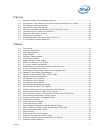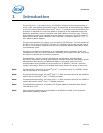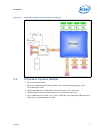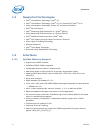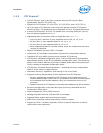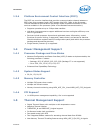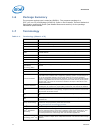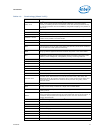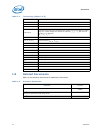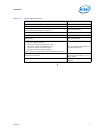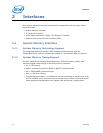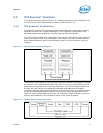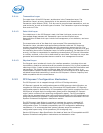
Datasheet 13
Introduction
1.3.4 Platform Environment Control Interface (PECI)
The PECI is a one-wire interface that provides a communication channel between a
PECI client (the processor) and a PECI master (the PCH). Refer to the Processor
Thermal Mechanical Specifications and Design Guide for additional details on PECI
services available in the processor (Refer to the Related Documents section).
• Supports operation at up to 2 Mbps data transfers
• Link layer improvements to support additional services and higher efficiency over
PECI 2.0 generation
• Services include processor thermal and estimated power information, control
functions for power limiting, P-state and T-state control, and access for Machine
Check Architecture registers and PCI configuration space (both within the processor
package and downstream devices)
• Single domain (Domain 0) is supported
1.4 Power Management Support
1.4.1 Processor Package and Core States
• Advance Configuration and Power Interface (ACPI) C-states as implemented by the
following processor C-states:
— Package: PC0, PC1/PC1E, PC2, PC3, PC6 (Package C7 is not supported)
— Core: CC0, CC1, CC1E, CC3, CC6, CC7
• Enhanced Intel SpeedStep Technology
1.4.2 System States Support
• S0, S1, S3, S4, S5
1.4.3 Memory Controller
• Multiple CKE power-down modes
• Multiple self-refresh modes
• Memory thermal monitoring using MEM_HOT_C01_N and MEM_HOT_C23_N signals
1.4.4 PCI Express*
• L1 ASPM power management capability; L0s is not supported
1.5 Thermal Management Support
• Digital Thermal Sensor with multiple on-die temperature zones
• Adaptive Thermal Monitor
• THERMTRIP_N and PROCHOT_N signal support
• On-Demand mode clock modulation
• Fan speed control with DTS
• Two integrated SMBus masters for accessing thermal data from DIMMs
• New Memory Thermal Throttling features using MEM_HOT_C{01/23}_N signals



